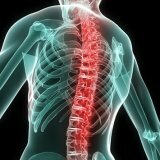Orthopedics of the chest in children

Due to sufficient rigidity, the organs inside the chest are in a constant position, which ensures the stability of their work. But in some cases, the fetus even before birth, the thorax changes its shape. At the same time, the position of internal organs inevitably changes, and their transformation takes place, as they adapt to sharply changing conditions. The thorax deforms, in most cases, even during the period of gestation, that is, this pathology is congenital. In the future, with intensive growth of the child, changes occur very rapidly. This can lead to negative consequences for the whole body.
Congenital deformity of chest
At present, physicians have not ascertained reliable causes of congenital deformities of the chest in children. However, any negative factors adversely affect the normal development of the fetus in the womb. The main causes of deformation are divided into three groups. Usually, with the development of deformity in the child, a partial combination is observed:
- uneven growth of the sternum and costal cartilage;
- pathology on the part of the diaphragm - excessively short parts of this muscle are capable of "pulling" in the form of the sternum of the baby inside;
- pathology of the development of connective tissue and cartilage of the child.
Chest deformity of chest
This deformation of the chest manifests itself in the westernization of the sternum, costal cartilage and anterior ribs. It occurs much more often than other congenital malformations of the chest. You can also meet such a figurative name as "the boot of a shoemaker".Since ancient times shoemakers, when working with force, have restrained the heel of shoes in the sternum( its lower third).This led to a professional deformation of their chest. Similar pathologies are often observed in close relatives, which confirms the genetic nature of this pathology.
The deformed chest is the cause of the development of other diseases in the child. Since the baby is actively growing, there is a rapid change in the shape of all other bones, especially the spine. There is also a change in the position and malfunctioning of the internal organs.
Symptoms of
Initially, this violation is not noticeable. Only with the growth of the child begins to form a "funnel".Children begin to lag behind in their development from peers, often suffer from cold diseases. Its maximum reaches its maximum by 3-4 years. Then she gradually stops in her progression. By this age, the child develops in addition to kyphosis and scoliosis, the development of disorders from all the organs of the chest, the asymmetry of the thorax becomes noticeable, her reduced excursion is marked by a pediatrician.
Thoracic deformity of the chest
This pathology represents an appreciable protrusion of the sternum forward, which visually gives the breast of the child the shape of the keel. The protrusion is due to the excessive growth of the children's costal cartilages, which seem to "push" the sternum forward. This increases the anterior posterior size of the thorax.
Symptoms of
The main symptom is a sharp and noticeable protrusion of the sternum forward. With age, the degree of deformation of bones increases. Unlike the previous pathology, such a keeled breast does not cause serious disturbances in the child. This can be explained by the fact that the volume of the chest does not decrease, and there is no compression of the internal organs. True, the position of the child's heart changes. It occupies an upright position, taking the form of a "hanging drop".Children with this pathology often complain of shortness of breath, quickly become tired.
If your child suffers from one of the forms of deformity of the breast, the only way to treat it is surgery - preferably at 3-5 years of age. If you perform an operation in adolescence, then you can not achieve improvement in lung function. Children under two years of age can not be surgically intervened. At the same time, surgical treatment is absolutely necessary for the majority of children with this pathology, since the deformation of the chest with age only increases, adding health problems and causing psychological trauma to the child.


